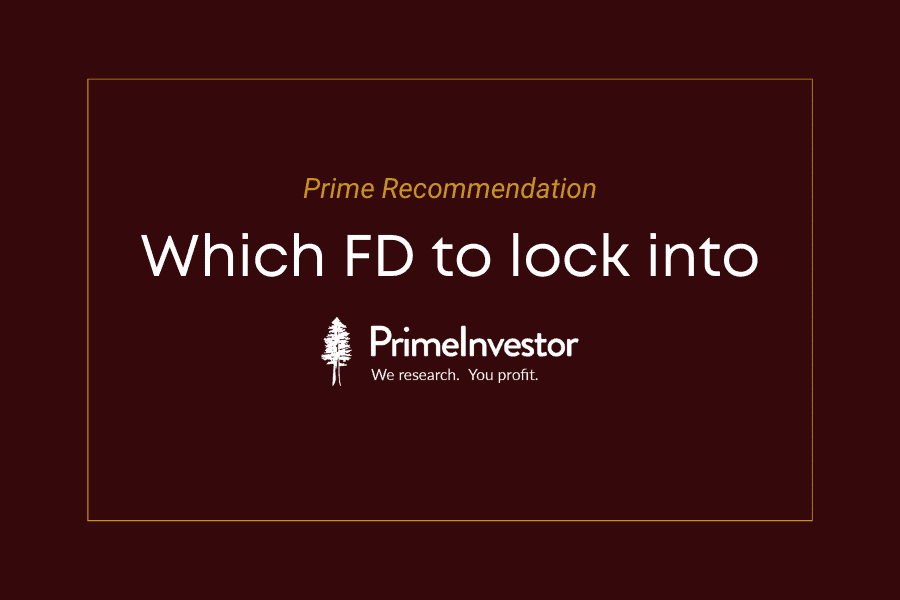We last took stock of fixed deposit options in our review of deposit schemes in January 2023. In that review report, we had argued that though interest rates on FDs from the good NBFCs had moved up, they were not attractive enough to lock in for the long term. Having closely tracked FD rates since then, we feel that it is time to revisit our FD recommendations. In this report, we assess where the rate cycle stands, the FD options you have, and what your FD strategy should now be.
We have also reviewed and updated our FD recommendations in Prime Deposits. The rationale for these changes are also explained in this report.

Rate outlook
To decide on the right FD strategy, it is important to take stock of where market interest rates stand today and how they are likely to move. The yield on the 10-year government security (g-sec), the benchmark for the bond market, sank to lows below 6% in 2020-21 during Covid. But with the economy normalising and inflation returning, the 10-year yield climbed steadily to peak at 7.45% in June 2022. After making a couple of attempts to break past 7.5%, the benchmark bond has since seen its yield fall to 7.07% levels. It has been hovering below 7.1% in recent weeks.
This recent decline has been triggered by the fall in CPI inflation readings and a pause by the MPC which sets policy rates. CPI inflation has fallen from 6.52% in February 2023 to 4.81% by June. Over 2022-23, the MPC hiked the repo rate by 250 basis points to 6.5% in a bid to quell rising inflation. Since March though, moderating inflation coupled with growth concerns have prompted the MPC to pause its rate hikes. It has held rates in its last two reviews in April and June.
Market interest rates usually anticipate MPC actions. So, what is the outlook for policy rates from here?
With El Nino playing havoc with the monsoon (deficient rains in South and North-east, surplus in North and North-west) there have been flare-ups in the prices of tomatoes, rice etc. Will this cause inflation to spike up again? It can, but it is early days yet to talk of a sustainable rise in CPI inflation.
For one, in recent years, India has moved into surplus with most food crops and agricultural output overall has been dependent both on the kharif and rabi crops. As we are still in the first leg of the South-west monsoon, shortfalls in acreage or damage to some crops can be made up in the rest of the season until September and in the rabi season thereafter.
Two, flare-ups in specific commodities such as tomatoes or rice will not materially affect the CPI because of their relatively low weights in the index basket. Only a concerted flare-up across commodities can cause the CPI to power up on a sustainable basis.
Now, the question is if CPI inflation does flare up and stay high, will the MPC resume its rate hikes? The possibility of this seems low in the current circumstances.
As the current bout of inflation is being triggered by domestic supply shocks, the government is likely to attempt to tackle it through supply side measures such as curbs on hoarding and exports and reduced tariff barriers on imports. The recent ban on rice exports and procurement and sale of tomatoes through the government platform are some recent measures that show that the Centre is taking this route.
With the General elections due in 2024, the government is likely to be keen to nip inflation in the bud before it surges beyond comfort levels. The MPC is also likely to be under political pressure not to act hastily on rates. MPC is also likely to recognise that rate hikes (that curb demand) are not a very effective tool to curb inflation in essentials caused by supply disruptions.
These factors suggest that the MPC may not rush to hike rates again. However, it may hold off cutting rates given that the inflation threat is still alive. This suggests that market interest rates may stay rangebound for now, neither moving up sharply nor falling.
FD opportunities
While 10-year g-sec yields have been cooling off from recent highs, certain segments of the bond market still offer attractive opportunities for locking into high yield.
- For one, while the yield on 10 year bonds have declined by 30-35 basis points from January, yields for 3-5 year tenors have not fallen as much. Given relatively tight market liquidity, yields on 3-year g-secs have firmed up slightly since January to 7.05% and the yield on the 5-year g-sec are marginally lower at 7.08%. Therefore, investing in corporate/NBFCs FDs ranging from 3 to 5 years makes sense now.
- Two, a reviving economy has created a strong demand for credit from companies and retail borrowers. This has led to NBFCs and companies borrowing actively in the 3 to 5-year bucket. Yields for corporate/NBFC FDs have remained elevated even as g-sec yields have moderated.
- Three, with banks seeing their deposit inflows lagging credit offtake, there has been scramble for collecting deposits. This has led to banks revising their 1 to 3-year FD rates upwards several times this year.
The following table illustrates how rates have moved.
Given that FD rates of top-quality NBFCs are already hovering above 8%, this appears to be a good opportunity to lock into these rates. Though there can upside to rates from here, the downside in case of the funding situation easing, is even higher. Therefore, rather than wait to catch the absolute top in FD rates, it appears prudent to lock in now.
Best FDs to lock into, by tenor
The above analysis suggests the following FD strategy for investors.
- If you are a non-senior investor looking to park money in FDs for the medium to long term, current rates are attractive enough to lock into 5-year FDs. When we issued the January 2023 strategy, the FD rates for AAA-rated NBFCs hovered at 7.35-7.6% for 4 and 5-year buckets. These rates have since climbed by between 30 and 55 basis points, to 7.9-8.35%. This in our view presents a good opportunity for FD investors to lock into high rates for the next 5 years. Given that the rate cycle is quite likely to see a downturn over the next 3-4 years, locking into longer term FD options can shield investors from reinvestment risk. HDFC, pursuant to its merger with HDFC Bank, has exited the public deposits market. This leaves investors with the choice of Sundaram Home Finance, Bajaj Finance and Mahindra Finance for their 5-year FDs in AAA rated space. While Sundaram Home offers 7.9%, Mahindra Finance and Bajaj Finance offer 8.05% for the 5-year FD for non-seniors. Check Prime Deposits for our recommendations in the 36-60 month tenors.
- If you cannot hold the FD for 5 years and are looking for a 3 or 4-year tenor, the best deals are available from Mahindra Finance and Bajaj Finance who offer 8.05% for non-seniors for both 3 and 4 years. Special rates are also available on in-between tenors. Bajaj Finance’s 8.35% for 44 months is superior to most other NBFC options even for 5 years and can be picked. Check Prime Deposits for our recommendations.
- If you have money to park only for 1-2 years, some good quality banks offer a better deal than NBFCs and should be preferred. Bank deposits are safer than those with NBFCs because of their deposit insurance cover up to Rs 5 lakh. Equitas Small Finance Bank and IndusInd Bank are our top picks here. Equitas offers 8.2% for 1 year, 8.5% for 444 days (roughly 1.2 years) and 8.5% for 888 days (roughly 2.4 years). Indusind Bank offers 7.57% for one year and 7.5% for 2 years. Both these banks figure among those which enjoy our high confidence according to our Bank FD comparison tool. Check Prime Deposits for our recommendations in the 12 and 12-24 month tenors.
- With the government raising the rates on small savings schemes very sluggishly, rates on post office time deposits now hover at 6.9-7% for 1-3 years and at 7.5% for 5 years. Non-senior investors can opt for banks and AAA-rated NBFCs over post office schemes for their convenience and higher rates. Though post office schemes have sovereign backing and are safer, risks attached to AAA rated NBFCs are not high at this stage in the economic cycle.
- The interest rate on the Senior Citizens Savings Scheme is at 8.2% for the current quarter. Given the safety factor, this should remain the top preference for seniors followed by the bank FDs recommended above. Options such as the Bajaj Finance 44-month FD (8.6% for seniors) can be explored after these are exhausted.







9 thoughts on “Prime Recommendation: Which FD to lock into”
if the tax bracket is higher (effective 39-42.27%) is it better to go for corporate bonds and liquid funds to get tax deferral, atleast
Liquid fund returns will be lower but corporate bond yes.
I am a senior citizen and i donot want to make FDs for more than 2 years. In banks, Axis bank is offering 7.85% for 13 months deposit. What is your advice to park funds in Axis bank FD.
Axis Bank being one of the largest this is a safe option. You can go with it.
A bit off topic, but if possible, pls give ur views(article) on where to put govt employee retirement proceeds(lumpsum) to invest/fixed income/FD or any other scheme (allocation wise) and their implications on tax.
Please consider options like Post Office Senior Citizens Savings Scheme, GOI Floating Rate Savings Bonds and government bonds thru RBI Retail Direct, before FDs with banks. We have covered these options in articles at prime investor.
Hi, could you please advise your views – on Shriram FDs- they are offering around 9% to senior Citizens, for 5yr tenure –is the company financially Ok, especially after the merger — am little worried about safety of capital. regds
In my view it is a riskier entity post merger and I feel the incremental rate they offer over AAA NBFCs or banks is not attractive.
Thanks for your valuable inputs– i too had some doubts, thats why needed an expert view
Comments are closed.